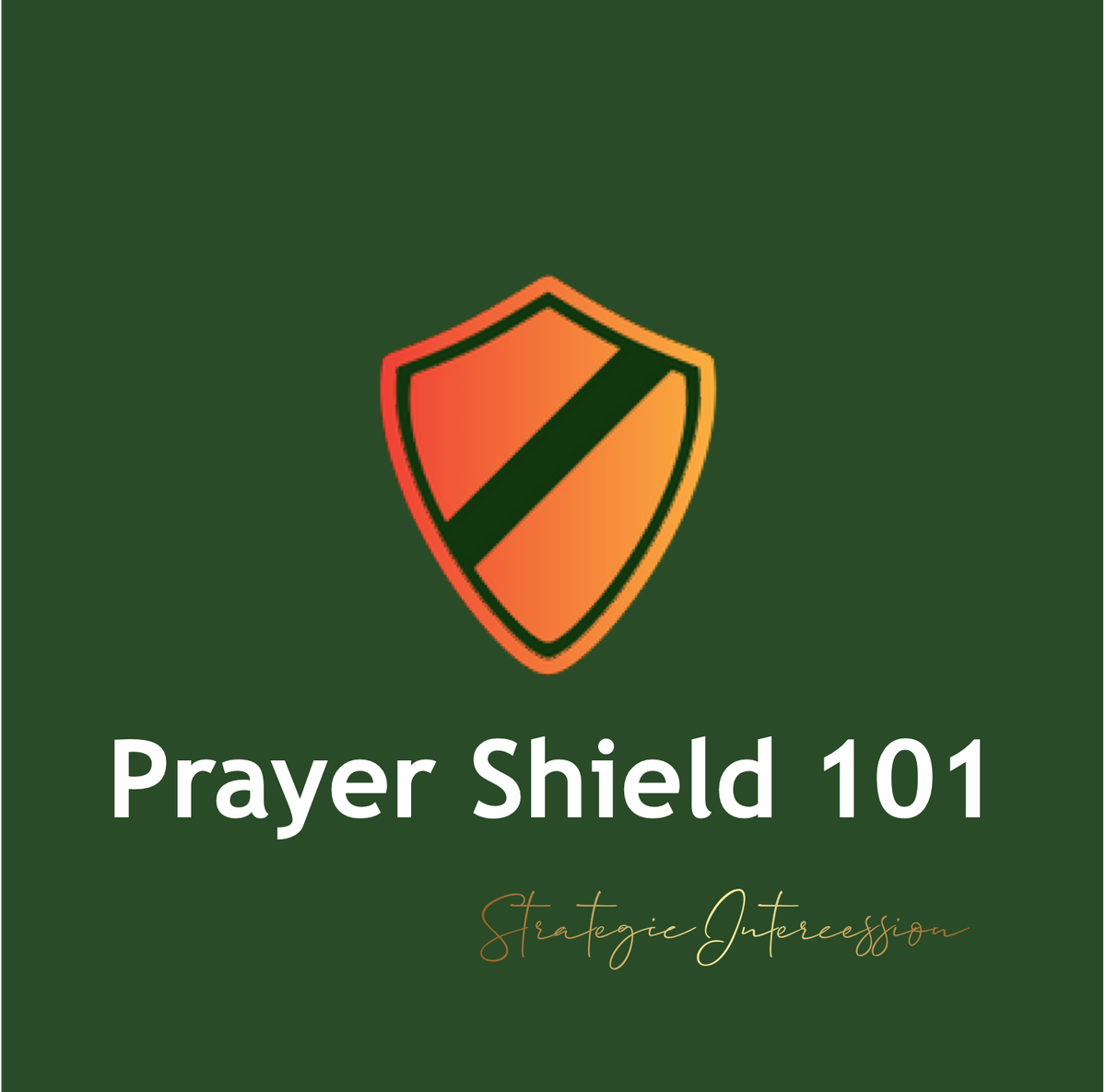Blog 8 - Building Your Personal Prayer Shield: A Leader's Guide to Spiritual Protection
A powerful prayer shield creates and maintains spiritual support that enhances your effectiveness as a Christian leader.

Building a prayer shield isn't just a nice idea—it's a game-changing strategy that can revolutionize your leadership and spiritual life. Hello Beloveds, today we're diving into this crucial topic, whether you're just starting out or looking to optimize your existing shield.
This episode will equip you with practical, actionable steps to build a powerful personal prayer shield, transforming your spiritual protection and enhancing your leadership effectiveness. Let's explore how you can create this vital support system for your leadership journey.
The Foundation of a Prayer Shield
First things first: what exactly is a prayer shield, and why is it so important? Simply put, a prayer shield is a dedicated group of intercessors who consistently pray for you and your leadership. It’s not just a nice-to-have; it’s a biblical concept that can significantly impact your effectiveness as a leader.
A powerful scripture that highlights the importance of a prayer shield is Ecclesiastes 4:12: “Though one may be overpowered, two can defend themselves. A cord of three strands is not quickly broken.” As leaders, we often find ourselves on the front lines of spiritual battles, and having a team of intercessors backing us up can make all the difference. If you missed episode 4, be sure to go back and listen - it’s titled Protect Your Leadership: The Vital Necessity of a Prayer Shield.
A prayer shield can be either temporary or permanent, and I build these two types of teams differently. A temporary shield is created to cover a specific event or mission, while a permanent shield is established to support a leader and the ongoing assignments God has entrusted to them.
As the missions coordinator for Victory Life Church in Colorado Springs—a wonderful, healthy fellowship of passionate believers—our church helps train the next generation of leaders, partly by offering mission field experiences. Each traveler plays a key role in evangelism, teaching, training, and activating church members in the field, all while experiencing their own fresh encounters with God.
Long before we embark on our journey, every participant is required to submit the emails of three intercessors who will focus on praying for them and the team’s mission. These names are then combined into a cohesive prayer shield that covers us during pre-trip warfare and readiness. The prayer shield is kept informed well in advance, and once we're on the field, I send daily updates as we navigate the fast-moving dynamic of challenges and witness the extraordinary moves of God. We keep our prayer warriors engaged by alerting them to potential trouble spots—whether logistical, emotional, or spiritual. And while we may joke about needing Imodium, we are intentional about keeping these warriors on the front line with us.
After King David won the retaliatory battle following the abduction of his army’s women and children from Ziklag, God instructed him to share the spoils equally with those who stayed behind to guard the baggage. In the same way, when we achieve big wins on the mission field, those victories also belong to those who stayed home, faithfully covering us as part of our temporary prayer shield. They are just as much a part of the mission as we are!
Structure Your Prayer Shield
In his book Prayer Shield, C. Peter Wagner introduces the concepts of primary, secondary, and tertiary prayer shields as layers of intercessory support designed to protect and sustain Christian leaders, especially those in ministry. These shields represent varying levels of engagement and commitment among those who pray for a leader.
The primary prayer shield is the most intimate and committed level of prayer support, made up of a small group of individuals who are deeply invested in the leader’s well-being and ministry. These are people with whom the leader has a close, trusting relationship. Since many leaders don’t have intercessory support, creating a primary prayer shield is an excellent starting point. For leaders with broader influence, I recommend eventually expanding to establish secondary and tertiary prayer shields as well.
Members of the primary prayer shield typically pray frequently for the leader. They are entrusted with the leader’s most personal and sensitive prayer needs, including spiritual battles, personal struggles, and specific work or ministry challenges. The leader regularly communicates with these intercessors, sharing detailed and often confidential information that enables them to pray more effectively.
In contrast, the secondary prayer shield consists of a larger group of intercessors who are committed to praying for the leader but may not have the same level of intimacy or access to personal information as those in the primary shield. These individuals are usually part of the leader’s broader network, such as congregation members, ministry partners, or close associates. They focus on broader needs, like the leader’s general health, protection from spiritual warfare, and success in initiatives. A designated point person provides this group with regular updates, highlighting specific areas where prayer is needed without delving into the most personal or sensitive details.
The tertiary prayer shield is the largest and most generalized level of prayer support. I’ve observed that many leaders rely almost entirely on this type of prayer shield, often combined with a crisis intercession hotline. However, this strategy doesn’t provide sufficient prayer coverage or the strategic intercession needed to overcome obstacles and intense spiritual warfare.
A tertiary prayer shield includes a broad range of people who may not have a direct relationship with the leader but are willing to pray for them. This group can include members of a larger church body, casual supporters, or distant acquaintances within the leader’s wider spiritual community. Intercessors in a tertiary shield generally pray less frequently and focus on broader, less specific needs, such as the overall success of the leader’s ministry or Kingdom assignment, protection from external threats, and general well-being.
Updates to this group are often less frequent and more general, possibly shared through newsletters, church announcements, or social media. The communication aims to mobilize a large number of people to pray without requiring the close, personal involvement that characterizes a primary or even a secondary shield. If, as a Christian leader, you rely upon your newsletter, social media, or church body, hoping that someone is actually praying for you, you have a tertiary prayer shield. While we value every prayer, understand that although a tertiary shield can support your work, it cannot open the path before you through targeted, informed, strategic intercession. You need more!
Dr. Wagner’s concept of three layers of prayer shields is designed to create a comprehensive, multi-faceted support system for leaders.
The different levels allow for a tailored approach, with the most sensitive and critical prayer needs being entrusted to those closest to the leader while still engaging a wider community in prayer for broader needs. This structured approach helps ensure that leaders are continually surrounded by prayer, reducing the risk of burnout and spiritual attack and enabling them to lead more effectively.
Unfortunately, many of today’s Christian leaders lack genuine intercessory support beyond their own earnest prayers for the assignments God has given them. Is this where you find yourself?
I think we can agree – in an eschatological sense, the hour is late – and in these tumultuous times, targeted prayer is crucial to accomplishing your mission.
This episode will equip you to build an effective primary prayer shield, one that will strengthen you, protect you, and empower your service to the glory of God.
Identify Potential Prayer Shield Members
When selecting members for your prayer shield, it’s crucial to look beyond the obvious choices. Ask God to spotlight potential members for you. You need mature believers who can handle confidential information and maintain emotional balance. John Eldredge, in his book Get Your Life Back, talks about the concept of “benevolent detachment.”
“Benevolent detachment is the practice of giving everyone and everything to God. It’s the act of saying, ‘I am not responsible for fixing everything. I release it all to You, God,’ and then choosing to step back from the intensity of life’s demands. It’s a way of staying connected to the peace of God and allowing Him to be the one who carries the weight of the world.” -- John Eldredge
John encourages readers to embrace this practice as a way to reduce stress and regain a sense of peace. Eldredge emphasizes the importance of not carrying burdens that are not ours to carry, suggesting that detaching in a benevolent, loving way allows us to live more freely and stay connected to God. I’d also like to add that the skill of benevolent detachment protects intercessors against fear when the leader is taking God-ordained risks.
I have a precious family member who would like very much to be included in my official prayer shield updates. She is a powerful intercessor and loves me dearly. When I was headed to Togo on mission, she could sense the serious warfare awaiting my team. Because of her deep love for me, she found herself unable to pray at all, instead fixating on her wish that I would not go! Although I am certain she would make an excellent prayer shield member for a different leader, she is not able to benevolently detach from my mission particulars when I appear to be at risk.
If those you are considering for your prayer shield are not capable of benevolent detachment when interceding for your pain, losses, or risks, you may want to look at other potential members to ask.
Guidelines for Communication
Updates are crucial for targeted, strategic intercession. There are various ways to engage your team. If you are working among persecuted people groups or sharing your company’s sensitive information, you will need to carefully choose the information technology you use to convey these prayer requests. For example, email and some online chat apps are not secure.
When deciding what and how much to share with your intercessors, it's important to focus on being consistent in your communication, keeping the information manageable, and ensuring it's relevant to your mission. You might have strong opinions on Mongolian yak farming, but unless your mission involves evangelizing herdsmen on the ground, it's probably best to keep those thoughts to yourself and not confuse your prayer shield with them.
As an intercessor myself, I've learned that brief, focused updates are most effective. Lengthy emails can overwhelm busy prayer partners, potentially delaying or even preventing timely intercession. Let's ensure our communication style keeps our prayer shield engaged and responsive.
So the point here is to find that sweet spot where you offer enough information to inform and engage but not so much that your reader becomes overwhelmed or bogged down in the details. Remember, God knows the details already. Your Intercessors just need to know enough to be dangerous on their knees enforcing heavens’ bounty on your behalf.
Lengthy updates are a temptation when too much time has passed between those updates. Instead, prompt your Intercessors more frequently by sharing encouragement through answers to prayer and offering fresh, focused prayer targets. Only allow lengthier gaps between updates when life is quiet on the home front, not when life is moving at a fast pace, and you haven't made the time.
In the midst of your busy schedule, postponing prayer updates could unintentionally communicate something to your intercessors. Whether consciously or subconsciously, you believe your to-do list is more critical to your success than their prayers. I believe that consistent updates show how much a leader truly values the importance of prayer.
If you're neglecting updates to your intercessors, take a moment to evaluate whether your prayer shield has become a religious check box rather than an earnest response to how God has invited you into partnership with Him through dependency and authentic interdependency on others.
I love Martin Luther's response to being swamped by responsibilities: “ I have so much to do that I shall spend the first three hours in prayer."
Practically speaking, for a very busy Kingdom advancer, updating intercessors once a week is plenty unless engaged on mission. For example, when I'm traveling, I may update my Intercessors daily on field dynamics, warfare, and praises. But I also have quiet seasons where they hear from me only once a month. I don't want them to feel overburdened or swamped by my needs.
Overcoming Common Pitfalls
Let’s talk about avoiding or overcoming some common pitfalls in establishing a prayer shield. The first pitfall is improperly going about populating your team. When you realize you lack prayer coverage, it can be tempting to automatically add people you respect to your prayer shield and then inform them of their new role. And yes, this has happened to me with a leader making an “assumptive close” to put me on their prayer team.
When considering a prospective intercessor for your prayer team, it’s crucial to respect their capacity and ensure they feel led by God to participate. Assigning or inducting someone into your prayer shield without their consent can be disrespectful, even if unintentionally so. Always approach this process with sensitivity, allowing them the freedom to prayerfully consider their involvement.
First, ask God who to invite, and then thoughtfully extend an invitation to serve. Clearly outline the commitment: how long it will last, what is expected, and the importance of confidentiality. Make sure a potential prayer shield member knows that saying 'no' doesn't mean they're disappointing you.
A primary prayer shield is not a mass email newsletter, where email updates are sent out hoping someone will pray, like throwing a Hail Mary pass and hoping for a touchdown. An effective primary prayer shield is crafted with care and is a crucial part of your leadership strategy. Members are carefully and prayerfully selected, and then they thrive on regular updates, affirmation, encouragement, and genuine appreciation. A well-functioning, effective prayer shield is a true treasure, essential to your success as a leader.
Spotlighting pitfalls is a way to illuminate your path, helping you avoid trouble before it happens. The second pitfall to watch for involves the scope of coverage and the size of your prayer team.
It is crucial to match the size of your prayer shield to your needs. If your span of influence is large, your prayer shield should be, too, ensuring Intercessors are not overwhelmed by too many prayer requests. Each member should have the freedom to read your updates and focus on the areas Holy Spirit highlights for them. When there are too few intercessors to cover your needs adequately, team members might feel pressured to cover more in prayer than they can handle comfortably. The scope of your needs should align with the manpower available.
If your prayer shield is small, consider voluntarily limiting what they pray for. Start with a focused approach, clearly outlining which aspects of your leadership are included in your prayer shield’s responsibilities. As your team grows, you can expand the coverage to include more of your Kingdom assignments.
As your sphere of influence expands, a larger prayer shield can be organized into smaller teams within the broader group. Ask members which aspects of your leadership they feel the most affinity for. Then, give those members a specific focus while providing every member with a single all-inclusive update to provide an integrated view of your particulars.
For instance, based on your intercessors' individual affinities, you might have some focusing on your family, others on your ministry, and different groups on each of your businesses. This approach helps protect your team from being overwhelmed by large-scale demands while ensuring every area of your life is covered through strategic prayer.
Longevity
When I invite intercessors to join my prayer shield, I assure them from the start that the commitment is only for one year. To keep things simple, everyone’s term ends at the same time each year, regardless of when they joined. I never want one of these precious ones to feel stuck or obligated. Priorities shift, schedules fill up, and relationships change. Sometimes, an intercessor may go through a rough season, and adding my challenges to their own struggles is just too much for them.
My goal is always to express deep gratitude! So, each year, I thank my intercessors again and give them the opportunity to either gracefully step down or to commit for another year.
Because I love each and every member of my prayer shield, I desire to foster deep spiritual connections with them. I want their participation to actually feed them and not to drain them. A healthy prayer shield is a win-win arrangement – you receive prayer support, and they grow spiritually through the process. So, as I share updates with my intercessors, I also entrust them with my own personal spiritual insights and edifying experiences from my spiritual journey. I have been joyfully amazed by the longevity of service on my prayer shield, with some members faithfully serving since its inception fifteen years ago.
Unleashing Your Prayer Shield’s Full Potential
Let’s recap the key points and discuss how you can take action today.
- Prayerfully select your team members who can practice benevolent detachment.
- Structure your shield to match your needs, starting with a strong primary shield.
- Communicate consistently and effectively, finding the right balance in your updates.
- Craft updates carefully to cover critical aspects of your leadership for targeted, strategic intercession.
- Foster deep spiritual connections with your intercessors.
I encourage you to take immediate action on what you’ve learned today. Whether you’re starting from scratch or improving an existing prayer shield, every step you take strengthens your spiritual protection and enhances your leadership effectiveness.
If you're ready to take the next step in building your own powerful prayer shield, I've prepared a free resource just for you. Our Prayer Shield Mastery Guide is packed with practical steps and strategies to help you create, maintain, and optimize your prayer support system. It covers everything we've discussed today, from structuring your shield to overcoming common pitfalls.
This guide will be an invaluable tool as you implement what you've learned today and start experiencing the transformative power of a well-structured prayer shield in your leadership.
Remember, you don’t have to lead alone—God is with you, and with a dedicated team of intercessors, you’ll have the support you need to navigate the challenges ahead. Keep investing in your prayer shield, stay connected with your intercessors, and lead with confidence, knowing you’re covered in prayer every step of the way.




